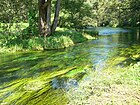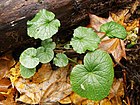Note: This is a project under development. The articles on this wiki are just being initiated and broadly incomplete. You can Help creating new pages.
Difference between revisions of "Eutrema japonicum - Wasabi"
| Line 1: | Line 1: | ||
[[File:Wasabia japonica 4.JPG|thumb|right|''Wasabi'']] | [[File:Wasabia japonica 4.JPG|thumb|right|''Wasabi'']] | ||
| − | |||
'''Wasabi''' is a plant of the Brassicaceae family, which includes cabbages, horseradish, and mustard. The plant grows naturally along stream beds in mountain river valleys in Japan. | '''Wasabi''' is a plant of the Brassicaceae family, which includes cabbages, horseradish, and mustard. The plant grows naturally along stream beds in mountain river valleys in Japan. | ||
==Uses== | ==Uses== | ||
| − | {{Uses|Heart problems}}, {{Uses|Cancer}}, {{Uses|Osteoporosis}}, {{Uses| | + | {{Uses|Heart problems}}, {{Uses|Cancer}}, {{Uses|Osteoporosis}}, {{Uses|Sinuses}}, {{Uses|Arthritis}}, {{Uses|Respiratory problems}}, {{Uses|Gut Health}}, {{Uses|Sore throats}} |
==Parts Used== | ==Parts Used== | ||
Revision as of 17:36, 9 October 2018
Wasabi is a plant of the Brassicaceae family, which includes cabbages, horseradish, and mustard. The plant grows naturally along stream beds in mountain river valleys in Japan.
Contents
- 1 Uses
- 2 Parts Used
- 3 Chemical Composition
- 4 Common names
- 5 Properties
- 6 Habit
- 7 Identification
- 8 List of Ayurvedic medicine in which the herb is used
- 9 Where to get the saplings
- 10 Mode of Propagation
- 11 How to plant/cultivate
- 12 Commonly seen growing in areas
- 13 Photo Gallery
- 14 References
- 15 External Links
Uses
Heart problems, Cancer, Osteoporosis, Sinuses, Arthritis, Respiratory problems, Gut Health, Sore throats
Parts Used
Chemical Composition
MITC, methylthioheptyl isothiocyanate, methylthiooctyl, isothiocyanate[1]
Common names
| Language | Common name |
|---|---|
| Kannada | |
| Hindi | |
| Malayalam | |
| Tamil | |
| Telugu | |
| Marathi | NA |
| Gujarathi | NA |
| Punjabi | NA |
| Kashmiri | NA |
| Sanskrit | |
| English | Agrimony |
Properties
Reference: Dravya - Substance, Rasa - Taste, Guna - Qualities, Veerya - Potency, Vipaka - Post-digesion effect, Karma - Pharmacological activity, Prabhava - Therepeutics.
Dravya
Rasa
Guna
Veerya
Vipaka
Karma
Prabhava
Habit
Identification
Leaf
| Kind | Shape | Feature |
|---|---|---|
| Simple | The leaves are divided into 3-6 toothed leaflets, with smaller leaflets in between |
Flower
| Type | Size | Color and composition | Stamen | More information |
|---|---|---|---|---|
| Unisexual | 2-4cm long | Yellow | 5-20 | Flowers Season is June - August |
Fruit
| Type | Size | Mass | Appearance | Seeds | More information |
|---|---|---|---|---|---|
| clearly grooved lengthwise, Lowest hooked hairs aligned towards crown | With hooked hairs | {{{6}}} |
Other features
List of Ayurvedic medicine in which the herb is used
- Vishatinduka Taila as root juice extract
Where to get the saplings
Mode of Propagation
How to plant/cultivate
Prefers a position in wet soil or shallow water[2]
Commonly seen growing in areas
Photo Gallery
References
External Links
Categories:
- Ayurvedic Herbs known to be helpful to treat Heart problems
- Ayurvedic Herbs known to be helpful to treat Cancer
- Ayurvedic Herbs known to be helpful to treat Osteoporosis
- Ayurvedic Herbs known to be helpful to treat Sinuses
- Ayurvedic Herbs known to be helpful to treat Arthritis
- Ayurvedic Herbs known to be helpful to treat Respiratory problems
- Ayurvedic Herbs known to be helpful to treat Gut Health
- Ayurvedic Herbs known to be helpful to treat Sore throats
- Herbs with Stem used in medicine
- Herbs with Root used in medicine
- Herbs with common name in English
- Habit - Herb
- Index of Plants which can be propagated by Seeds
- Index of Plants which can be propagated by Cuttings
- Herbs that are commonly seen in the region of humid
- Herbs that are commonly seen in the region of temperate
- Herbs





